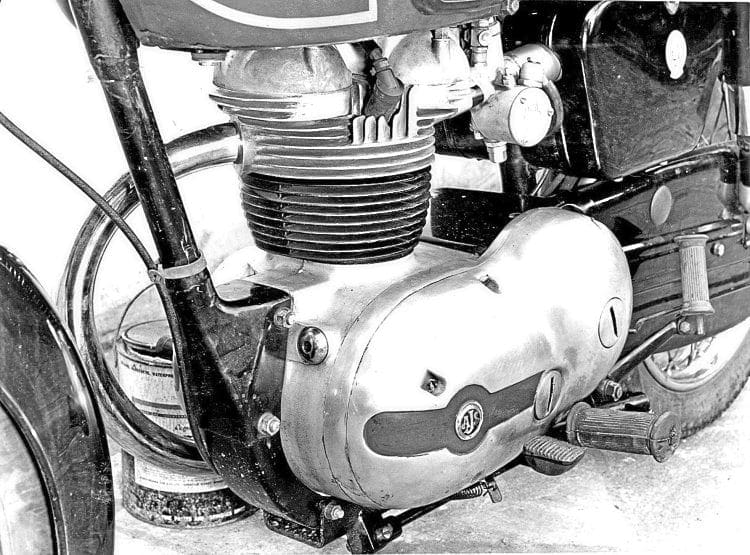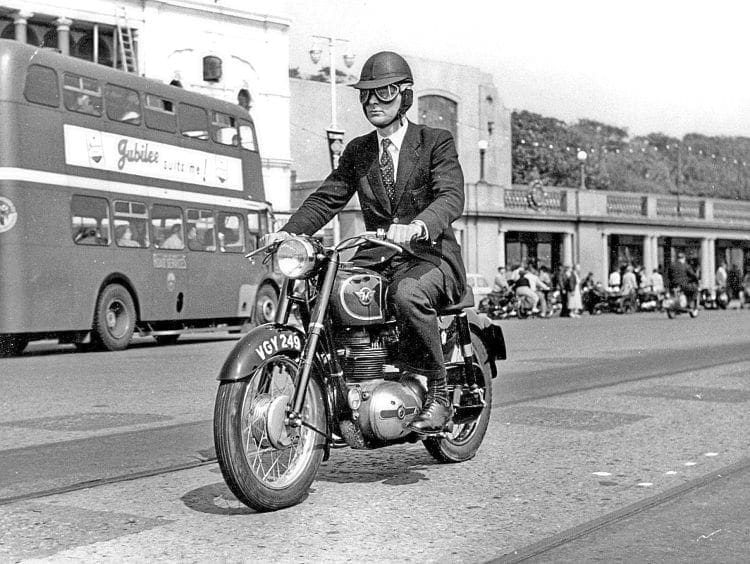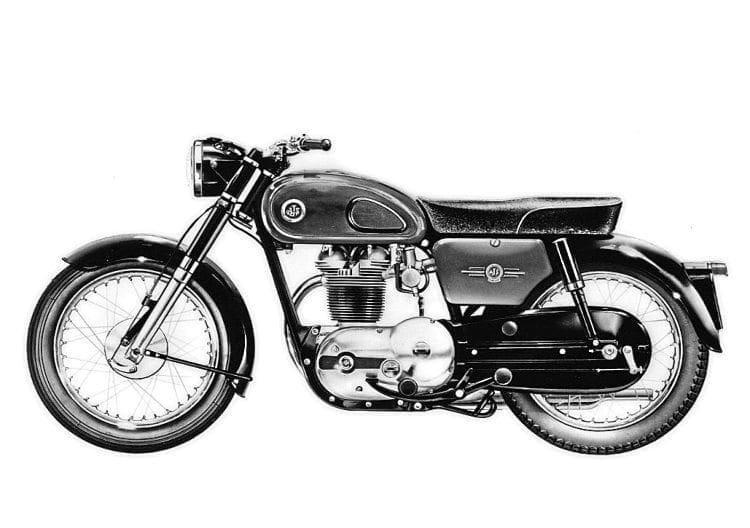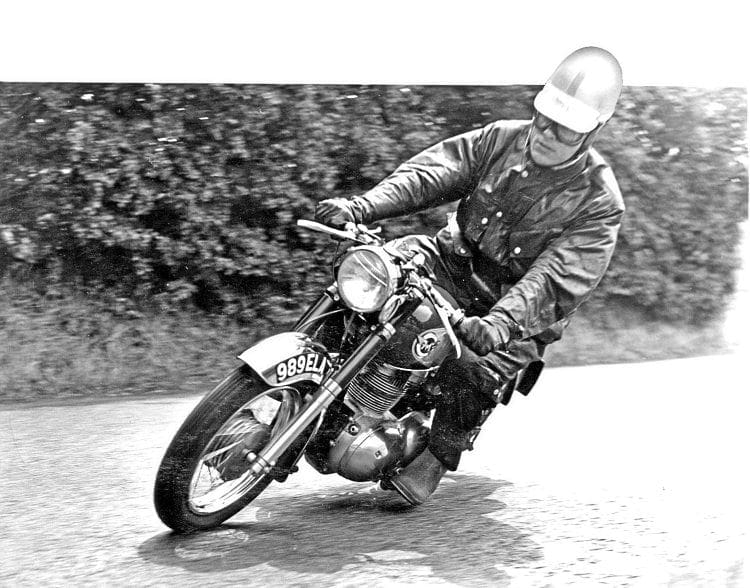Time was slowly running out for Associated Motor Cycles when it launched its new-style 250cc overhead-valve singles in 1958 – but were the sturdy and neat-looking AJS and Matchless models the best they could have offered? asks Pete Kelly.
By the time Associated Motor Cycles launched its apparently unit-construction 250cc overhead-valve Matchless G2 and AJS 14 models in May 1958, Ducati was already marketing a range of brilliant overhead-camshaft singles in capacities ranging from 100 to 200cc… and 250cc versions wouldn’t be long in coming.
So why would AMC want to plump for a rather overweight and, in some ways imperfect, push-rod design, and then market the new models under the badge-engineered guises of two of the most revered names in British motorcycle history?
As in all things, it probably boiled down to price and practicality, with items like the initial Francis-Barnett front forks (eventually replaced by Teledraulics) coming from AMC’s ‘parts bin’.
And after all, with the little Ducatis proving eye-wateringly expensive, and game-changers like Honda’s CB72 still well over the horizon, the new models merely had to compete with the practical British opposition of the time.
The newcomers’ ‘unit-construction’ appearance was achieved by fitting rather ungainly side castings to hide the gearbox, clutch and primary drive, but at least their smooth contours aided cleaning.
In 1960 the 250cc models were supplemented by 350cc versions, the only engine difference apparent to the casual observer being an extra two fins on the barrel of the larger-capacity machines.
Initial reliability issues included broken crankpins and premature main bearing wear, but one by one the problems were resolved, and later versions were generally better machines. With the sad demise of AMC, however, the last ones were made in 1966.

Many still see these AMC ‘lightweights’ as the Cinderellas of their time, but those that are left remain affordable, and with a little care can be made into smart and reliable machines.
With a top speed of around 75mph with the rider crouched right down, performance was nothing out of the ordinary – but back in the 1960s my brother was so keen to get into road racing that he actually tuned one as far as he could and, with a silver frame, rose pearl tank and holes drilled everywhere, entered it in a few clubman’s events at Oulton Park… and he didn’t finish last!
So how did the motorcycling press receive AMC’s newcomers? By polite appraisal with just a little damning by faint praise is probably the best answer.
The April 20, 1961 issue of The Motor Cycle tested an AJS Model 14, with its fully-enclosed chain case and upright riding position, and the November 9, 1961 issue of Motor Cycling a Matchless G2S Monitor Sports with more sporting pretensions – yet in overall performance they were virtually indistinguishable.
The Motor Cycle’s road test began with one of the longest and most convoluted opening paragraphs I have ever read: “Of the new two-fifties introduced by British manufacturers in the past few years, the AJS models are well to the fore. Cleanly styled externally, engine and gear box are separate units although they appear to be integral. T
“he gear box, cylindrical in shape, is clamped by two metal straps to an arc of matching radius on the rear of the crankcase casting. And as the main shaft is eccentric to the shell, rotation of the box provides adjustment for the primary chain.

“The désaxé arrangement of the cylinder – its axis is set ¼in ahead of the crankshaft axis – minimises the possibility of piston slap and reduces connecting-rod angularity when combustion pressure is at maximum.”
Is anyone still awake?
At 343lb fully equipped, the Model 14 was undoubtedly heavier than many of its competitors, especially those in the two-stroke field – but (and here comes the first bit of faint praise) “the Model 14 has most of its weight low down, so consequently handling on the move is not impaired”.
Costing £203-17s-2d including purchase tax in 1961, the more staid Model 14 managed a highest one-way speed of 77mph – better than the 74mph Motor Cycling managed with the Matchless Monitor Sports at MIRA – but still not bad for the day.
The Model 14’s ease of starting, impressive fuel economy and fully-enclosed rear chain were duly praised, but in other regards, the testers’ enthusiasm remained muted. “Both brakes, though progressive in action, lacked real power,” went The Motor Cycle’s report. “Heavy pressure was required on the front brake lever, and while the rear brake was light in operation, only by applying excessive pressure could the wheel be locked.

“The lighting restricted after-dark cruising to 50mph or so because the headlamp threw only a moderately well-defined beam. The cut-off on the dipped filament was adequate, but the horn could, with advantage, have been louder.”
I suppose diplomacy dictated that the tester couldn’t just come straight out with it and say that the lighting and horn were completely inadequate.
Another point made was: “A reserve-type fuel tap is not fitted, but if one of the two taps is used, the second traps a useful reserve supply.”
More faint praise came in the shape of: “Ample bottom-end punch and excellently-chosen gear ratios endowed the model with useful acceleration, although there was occasionally a hesitation on opening up from very low engine speeds, and the flat spot could not be eliminated by adjusting the pilot-air screw.
“If the revs were allowed to soar, really snappy results were forthcoming. The only indication from the engine that it was beginning to work was a rising exhaust note, deep in tone but never offensive.
“The engine was delightfully smooth, and vibration, up to 60mph, virtually absent. Above that speed a slight, high-frequency tremor was noticeable at the handlebar.”
Normally, there might have been a summing-up paragraph that went something like: “Despite these little irritations, the Model 14 is a solid, nice-looking and good handling machine that anyone would be proud to own,” but this was strangely absent from The Motor Cycle’s report.

I always believed generally that the rival ‘Green ‘Un’, Motor Cycling, was normally that bit more critical when it came to road tests, but its November 1961 report of the Matchless G2S Monitor Sports began a little more warmly: “Pleasing in appearance and performance, the Matchless G2S Monitor Sports (like its AJS stablemate the Sapphire Sports) is a welcome contribution to the important 250cc sports sphere by Associated Motor Cycles.
“In the largest-capacity class legally open to a solo learner, its single-cylinder engine – which is said to develop 19 to 20bhp – gives it a potential that will satisfy him long after he has passed his test.”
The Monitor Sports had done only 23 miles when Motor Cycling took delivery, but with careful running-in it freed noticeably by the time it had over 1000 miles on the clock and was taken to the MIRA testing facility near Nuneaton.
Virtually the same mechanical engine description that The Motor Cycle’s report had given went: “Considerably over-square, the engine is désaxé, the centre-line of its cylinder lying slightly ahead of the crankshaft.
Besides this, its light-alloy cylinder head is skewed horizontally, with rockers and ports at an angle of 20 degrees to the fore-and-aft axis of the machine – an arrangement that increases the efficiency of valve gear operation, improves cooling and gives easier access to the carburettor.”

One characteristic of over-square engines, continued the report, is that they have to be kept on the boil for the best results. “Yet although the Matchless could be revved hard and long without showing signs of fatigue, it also had good torque lower down the scale.
“Once the engine had warmed up, carburation was usually clean, but when cold, generous use of the choke was needed. There was no hesitation at low engine speeds, as can occur with ‘hot’ valve timings, and the Monitor zipped straight up the scale without faltering.
“Use of such a surge of revs and power in, say, second gear, up to the 6800rpm peak showed no serious vibration. Mechanically, the unit was quiet, though the gearbox whined under power in second and particularly in third, but bottom was silent. The sharp exhaust bark might, however, be muted to advantage.”
Some aspects were far from rosy. “With the machine under way, clutch action was delightful and the lever pressure needed quite light, but when engaged from rest, the clutch had a tendency to grab even after factory attention,” went the report.
“Gear changing was good, particularly at speed when one could slip through the cogs very slickly; and, given nothing more than normal matching of engine and road speeds, the changes were absolutely clean.
“Gear ratios, however, were not so ideal. Although top is slightly low for all-out, flat-on-the-tank speed, it is right for the fastest possible progress with the rider normally seated – and we prefer it that way.

“But third is a long way down, and bottom is exceptionally low. In fact the tester frequently pulled away on a level road in second gear rather than make unnecessary use of bottom, which seemed only for uphill starting and very slow traffic. It appeared that all three intermediate ratios might be higher with advantage.”
There was also some criticism of the riding position, “which could also be better tailored for the market for which the Monitor Sports was aimed. The footrests are rather low, and scraped when spirited cornering was attempted – in fact greater ground clearance in general would be an advantage.
“Also, the handlebars are hardly a good compromise (though they might suit some statures) and their range of adjustment is limited. In fact, it seems as though a touring position has been adapted without giving the rider the option of returning to a more upright attitude”.
While oil consumption was judged to be good at roughly one pint per 1000 miles, the tester found the level difficult to judge. The oil went in through an accessible orifice at the front of the right-hand crankcase half, but its level had to be maintained at a specific distance below the return hole, and a dipstick would have been advantageous.
The Monitor Sports scored high marks for handling, but the 6in front drum brake seemed below par and had to be applied really hard when short-distance stopping was required.
Motor Cycling gave the lighting a much better appraisal than its rival had given to the AJS Model 14. “Lighting intensity provided by the Wipac electrical equipment was excellent, and the generator showed good charging at all times, poking out a couple of amps regardless of services switched on even at the minimum non-snatch speed of about 20mph in top,” the report continued.
“The headlight’s main beam pattern was exceptionally good, having a long-range pencil probing ahead with a wide pool nearer to the machine – ideal for illuminating manhole covers. Dipped, the beam was also good, but emitted rather a lot of stray light.”

The report concluded: “Though we have criticised a few detail points, the Matchless G2S Monitor Sports is a good machine. In fact the minor snags we discovered detract in only the slightest degree from what is a highly-desirable British sports two-fifty with abundant go, good manners and economy of operation.
“And, in its shining chrome guards, with red and white tank, it’s a graceful mount of which any new owner could be justifiably very proud.”
Old Bike Mart would love to hear from any readers who still own one of these machines whether they agree with the road testers’ findings of 55 years ago, or whether, with the advantage of hindsight, they find them better or worse than painted?
Read more News and Features at www.oldbikemart.co.uk and in the latest issue of Old Bike Mart – on sale now!





